| View previous topic :: View next topic |
| Author |
Message |
wolan


Joined: 30 Jun 2015
Posts: 577
Location: Zurich
|
 Posted: Wed Mar 09, 2022 10:42 am Post subject: Canon FD 50mm f1.2 L Posted: Wed Mar 09, 2022 10:42 am Post subject: Canon FD 50mm f1.2 L |
 |
|
wolan wrote:
Hi,
I have seen some nice pictures on Flick taken with this lens. I like the bokeh and sharpness WO seems to be rather good.
What do you think of this lens? How does it stack in your opinion against other vintage 50/55 f1.2 lenses (in particular against the Canon 55 f1.2 SSC)?
I have experience with the Nikon 50mm, which I did not like because its nervous bokeh, and the Tomioka 55mm f1.2, which has a wonderful bokeh, but sharpness WO is not particularly exciting.
Please share some photos if you have any.
Cheers.
_________________
https://www.flickr.com/photos/149089857@N03/ |
|
| Back to top |
|
 |
caspert79


Joined: 31 Oct 2010
Posts: 3225
Location: The Netherlands
|
 Posted: Wed Mar 09, 2022 12:08 pm Post subject: Posted: Wed Mar 09, 2022 12:08 pm Post subject: |
 |
|
caspert79 wrote:
If you're willing to spend quite a bit of money why not look at the Voigtlander Nokton 50mm f/1.2? Stopped down its center resolution is even higher than the Voigtlander 50/2 APO-Lanthar.
_________________
For Sale:
Steinheil Auto D Tele Quinar 135mm f/2.8 (Exa)
ISCO Isconar 100mm f/4 (Exa)
Steinheil Cassarit 50mm f/2.8 M39 (Paxette)
I'm always interested in trading lenses! |
|
| Back to top |
|
 |
wolan


Joined: 30 Jun 2015
Posts: 577
Location: Zurich
|
 Posted: Wed Mar 09, 2022 12:35 pm Post subject: Posted: Wed Mar 09, 2022 12:35 pm Post subject: |
 |
|
wolan wrote:
| caspert79 wrote: |
| If you're willing to spend quite a bit of money why not look at the Voigtlander Nokton 50mm f/1.2? Stopped down its center resolution is even higher than the Voigtlander 50/2 APO-Lanthar. |
Thanks for the tip, looks like a fine lens, but the bokeh is uninspiring and without character to my eye.
Cheers
_________________
https://www.flickr.com/photos/149089857@N03/ |
|
| Back to top |
|
 |
caspert79


Joined: 31 Oct 2010
Posts: 3225
Location: The Netherlands
|
 Posted: Wed Mar 09, 2022 3:15 pm Post subject: Posted: Wed Mar 09, 2022 3:15 pm Post subject: |
 |
|
caspert79 wrote:
| wolan wrote: |
| caspert79 wrote: |
| If you're willing to spend quite a bit of money why not look at the Voigtlander Nokton 50mm f/1.2? Stopped down its center resolution is even higher than the Voigtlander 50/2 APO-Lanthar. |
Thanks for the tip, looks like a fine lens, but the bokeh is uninspiring and without character to my eye.
Cheers |
Are you planning to use it on full-frame? For APS-C there are a few options that wont cost you an arm and a leg.
_________________
For Sale:
Steinheil Auto D Tele Quinar 135mm f/2.8 (Exa)
ISCO Isconar 100mm f/4 (Exa)
Steinheil Cassarit 50mm f/2.8 M39 (Paxette)
I'm always interested in trading lenses! |
|
| Back to top |
|
 |
wolan


Joined: 30 Jun 2015
Posts: 577
Location: Zurich
|
 Posted: Wed Mar 09, 2022 7:10 pm Post subject: Posted: Wed Mar 09, 2022 7:10 pm Post subject: |
 |
|
wolan wrote:
Full-Frame, on a Nikon Z6 to be precise
Cheers.
_________________
https://www.flickr.com/photos/149089857@N03/ |
|
| Back to top |
|
 |
PBFACTS


Joined: 24 Dec 2008
Posts: 569
|
 Posted: Thu Mar 10, 2022 12:17 pm Post subject: Re: Canon FD 50mm f1.2 L Posted: Thu Mar 10, 2022 12:17 pm Post subject: Re: Canon FD 50mm f1.2 L |
 |
|
PBFACTS wrote:
| wolan wrote: |
Hi,
I have seen some nice pictures on Flick taken with this lens. I like the bokeh and sharpness WO seems to be rather good.
What do you think of this lens? How does it stack in your opinion against other vintage 50/55 f1.2 lenses (in particular against the Canon 55 f1.2 SSC)?
I have experience with the Nikon 50mm, which I did not like because its nervous bokeh, and the Tomioka 55mm f1.2, which has a wonderful bokeh, but sharpness WO is not particularly exciting.
Please share some photos if you have any.
Cheers. |
olympus om 55mm 1.2 silver nose (=single coated) at 1.8

_________________
OM USER .. I KEEP/USE:
Om2 sp + T32 (grip/filter/zoom) + T8
+ Zuiko 16mm 3.5 / 55mm 1.2 / 65-200 4/ x1.4
+ Sigma 8mm 4.0 / 14mm 3.5 / 18-35 3.5-4.5
+ Tamron 35/105 2.8
+Tokina 150/500 5.6
+ Kiron 105/2.8 macro 1:1
+ Vivitar S1 90/180 falst field macro
+ 2x Doubler HR7
>>I SELL: OM10 + OM4ti
+ i sell: OM Md1 + Md 2 + Grip PowerPack + charger
+ i sell: OM Zuiko 24mm 2.8 / 28mm 3.5 / 50mm 1.8 / 50mm 1.4 / 50mm 3.5 macro / 35-70 3.6 / 35-105 3.5-4.5 / 75-150 4 / 500mm / 2xA
+ i sell: OM Kiron 28/105 3.2-4.5 / 1.5 converter
+ i sell: OM Makinon reflex 5.6/300 + Spector reflex (makinon) 500mm
+ i sell: OM Macro panagor extender 1:1
+ i sell: OM Sigma 16mm 2.8 fisheye (last version) / 21-35 3.5-4.2 ot/ 28-70 2.8 /1000mm mirror
+ i sell: Tamron 28-70 3.5-4.5 / 28-80 sp 3.5-4.2 / 28-135 sp 4-4.5 / /28-200 3.5 / 35-135 3..5-4.5 / 90mm sp macro 1:1 2.8
+ i sell: OM Soligor 2x doubler / x3 converte
+ i sell: Soligor FisheEye x0.15
+ i sell: OM Tokina 28/135 4-4.6 / 70/210 3.5 (= vivitar S1 v2)
+ i sell: OM Vivitar 28-70 3.5-4.8 / 28-90 s1 2.8-3.5 / 35-70 2.8-3.8 / 55/2.8 Macro 1:1 (komine) / 70-150 3.8 ot (kiron) / 75-150 ot 3.8 (tokina + 2x matched)
+ i sell : OM cosina 100-500 5.6/8 |
|
| Back to top |
|
 |
stevemark

Joined: 29 Apr 2011
Posts: 4088
Location: Switzerland
|
 Posted: Thu Mar 10, 2022 2:35 pm Post subject: Re: Canon FD 50mm f1.2 L Posted: Thu Mar 10, 2022 2:35 pm Post subject: Re: Canon FD 50mm f1.2 L |
 |
|
stevemark wrote:
| wolan wrote: |
Hi,
I have seen some nice pictures on Flick taken with this lens. I like the bokeh and sharpness WO seems to be rather good.
What do you think of this lens? How does it stack in your opinion against other vintage 50/55 f1.2 lenses (in particular against the Canon 55 f1.2 SSC)?
I have experience with the Nikon 50mm, which I did not like because its nervous bokeh, and the Tomioka 55mm f1.2, which has a wonderful bokeh, but sharpness WO is not particularly exciting.
Please share some photos if you have any.
Cheers. |
I have a few f1.2 normal lenses (though neither the Nikkor 1.2/50mm nor the Tomioka 1.2/55mm):
Canon FL 1.2/58, FD 1.2/55 and 1.2/50 L
Minolta MC-II 1.2/58, MC-X 1.2/58, MD-II 1.2/50 and MD-III 1.2/50
Nikkor-S Auto 1.2/55, Nikkor Ai 1.2/55
Apart from the FL 1.2/58mm (which was the first f1.2 SLR normal lens) all these lenses wide open have quite similar detail resolution (compared on 24 MP FF). All suffer quite badly from longitudinal CAs (color fringing), all have quite a bit of coma (the Canon 1.2/50L slightly less though ... but not much less). There are slight differences in bokeh between the Canon 50L and the Minolta. The MC 1.2/58mm of course has a rather different bokeh ... if you don't change the distance between you and the subject. If you keep the subject at the same size (ie you go a bit farther away), there's not much difference any more.
Canon 1.2/50L vs Canon 1.2/55 SSC: pretty similar detail resolution, color fringing etc (wide open). The 50 L has less coma though. Otherwise the larger image angle of the 50L pretty much "neutralizes" the advantages of its aspheric lens.
Some history as well: Minolta did have aspheric prototypes for its MD 1.2/50mm as well, but decided it was not worth to produce it. Which probably was right from an engineering standpoint - but Canon certainly made a lot of marketing noise about its aspheric 1.4/24, 1.2/50 and 1.2/85mm lenses ...
_________________
www.artaphot.ch |
|
| Back to top |
|
 |
tb_a


Joined: 26 Jan 2010
Posts: 3678
Location: Austria
Expire: 2019-08-28
|
 Posted: Thu Mar 10, 2022 4:12 pm Post subject: Posted: Thu Mar 10, 2022 4:12 pm Post subject: |
 |
|
tb_a wrote:
According to an old test report of a popular photo magazine the SMC Pentax K 50/1.2 was best in terms of center resolution wide open, even better than the so much appraised Canon L lens.
_________________
Thomas Bernardy
Manual focus lenses mainly from Minolta, Pentax, Voigtlaender, Leitz, Topcon and from Russia (too many to be listed here). |
|
| Back to top |
|
 |
cooltouch


Joined: 15 Jan 2009
Posts: 9096
Location: Houston, Texas
|
 Posted: Thu Mar 10, 2022 4:33 pm Post subject: Posted: Thu Mar 10, 2022 4:33 pm Post subject: |
 |
|
cooltouch wrote:
Somehow, that doesn't surprise me. Pentax has long been known for its crazy sharp optics.
_________________
Michael
My Gear List: http://michaelmcbroom.com/photo/gear.html
My Gallery: http://michaelmcbroom.com/gallery3/index.php/
My Flickr Page: https://www.flickr.com/photos/11308754@N08/albums
My Music: https://soundcloud.com/michaelmcbroom/albums
My Blog: http://michaelmcbroom.com/blogistan/ |
|
| Back to top |
|
 |
womble


Joined: 28 Sep 2009
Posts: 987
Location: Hertfordshire
|
 Posted: Thu Mar 10, 2022 6:43 pm Post subject: Posted: Thu Mar 10, 2022 6:43 pm Post subject: |
 |
|
womble wrote:
Pentax "K" 50mm f/1.2 images. Not ideal as they are down-sized and taken on a mixture of film and digital (and an older digital at that), but it gives you a bit of a feel for the lens. TBH, my copy of the K50/1.4 might be sharper stopped down a little than my copy of the 1.2 but I've never tested it. Proper lens tests are not my thing, I just use them and see if I like them. Also note I say "my copy" because with older lenses there is bound to be variation between examples.
Ilford Delta 100, lens wide open and hand held.
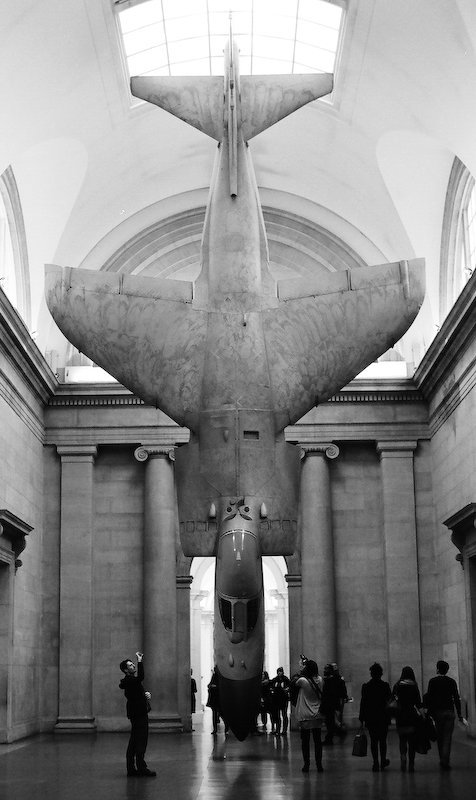
At the Museum (1) par Kris Lockyear, on ipernity
Fuji Neopan 1600, probably at about f/2, again hand held.
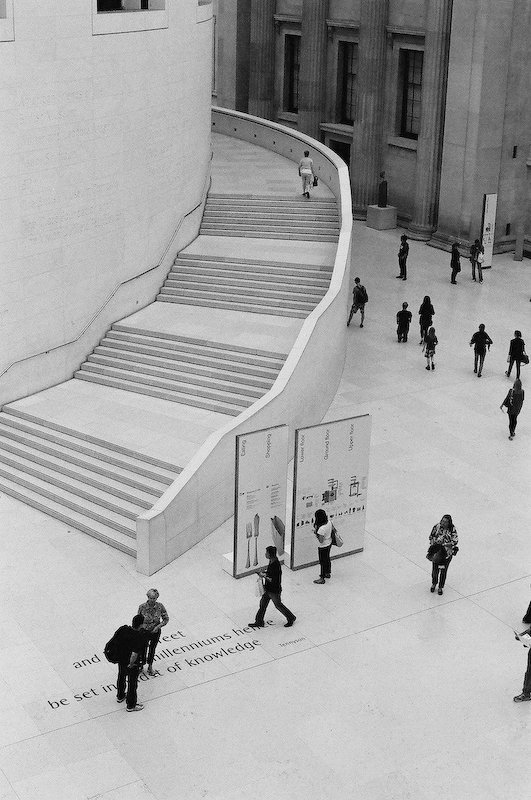
Be set in the midst of knowledge par Kris Lockyear, on ipernity
Pentax K20D. No idea what aperture, probably something middling. Hand held.
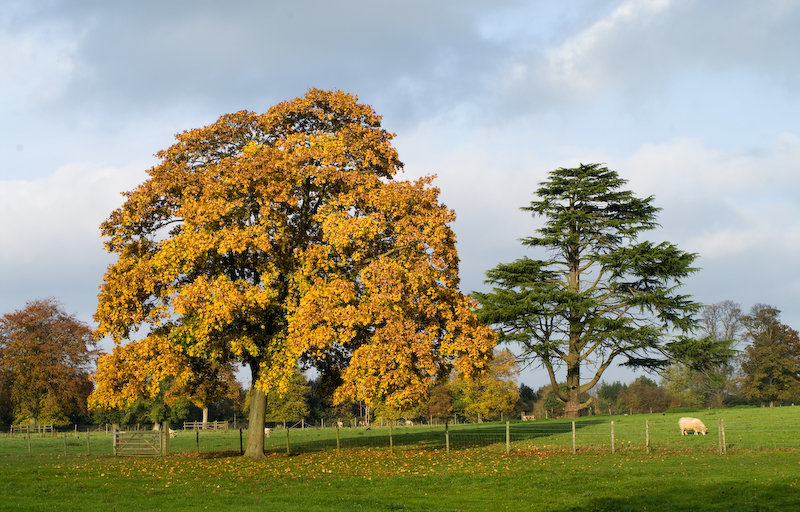
Autumn comes to Lamer par Kris Lockyear, on ipernity
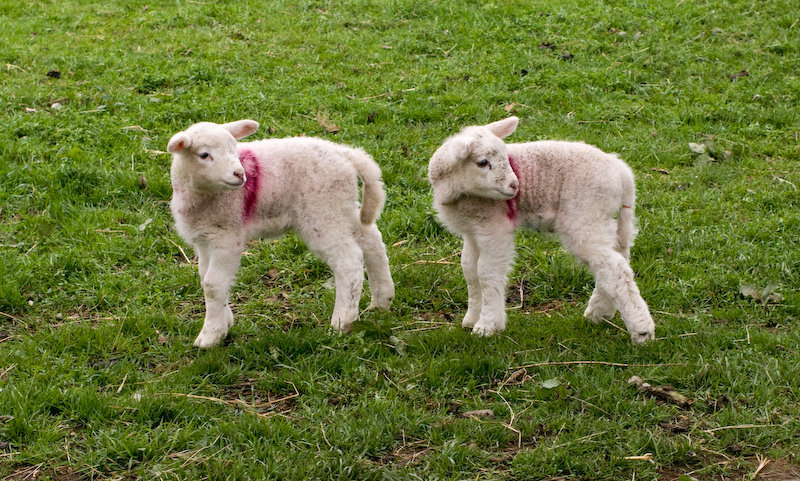
More lambs (1) par Kris Lockyear, on ipernity
_________________
Kris Lockyear
Digital: Pentax K-3iii
35mm film SLRs: various Pentax bodies from a H2 to a SF7, favourites the MX and LX
Rangefinder: Zeiss Super Ikonta IV, FED2, Zorkii-4, Industar 26m, Jupiter 8, 11 and 12 lenses
Medium format: various folders, Yashica Mat 124 G. Lubitel 2
LF: Horseman LE 5x4 view camera.
MF lenses (favourites) Pentax "K" 200mm f/2.5; "K" 135mm f/2.5; "K" 50mm f/1.2; "K" 35mm f/2; "K" 30mm f/2.8; "K" 28mm f/3.5 shift; "K" 15mm f/3.5; M 100mm f/2.8; M 40mm f/2.8; Jupiter-9 85mm |
|
| Back to top |
|
 |
tb_a


Joined: 26 Jan 2010
Posts: 3678
Location: Austria
Expire: 2019-08-28
|
 Posted: Thu Mar 10, 2022 11:21 pm Post subject: Posted: Thu Mar 10, 2022 11:21 pm Post subject: |
 |
|
tb_a wrote:
I've got 4 different F1.1 to F1.2 lenses from Fuji, Minolta, Pentax and 7Artisans which I've compared here if you scroll down: http://forum.mflenses.com/ultra-fast-normal-lenses-on-a7r-ii-t79965.html
In terms of sharpness the Fujinon is best. In terms of bokeh I prefer the Minolta lens.
_________________
Thomas Bernardy
Manual focus lenses mainly from Minolta, Pentax, Voigtlaender, Leitz, Topcon and from Russia (too many to be listed here). |
|
| Back to top |
|
 |
martinsmith99


Joined: 31 Aug 2008
Posts: 6950
Location: S Glos, UK
Expire: 2013-11-18
|
 Posted: Fri Mar 11, 2022 8:17 am Post subject: Posted: Fri Mar 11, 2022 8:17 am Post subject: |
 |
|
martinsmith99 wrote:
Do they really get used at their widest aperture?
Apart from test shots, I'm usually stopped down a bit for photographic purposes.
_________________
Casual attendance these days |
|
| Back to top |
|
 |
tb_a


Joined: 26 Jan 2010
Posts: 3678
Location: Austria
Expire: 2019-08-28
|
 Posted: Fri Mar 11, 2022 9:02 am Post subject: Posted: Fri Mar 11, 2022 9:02 am Post subject: |
 |
|
tb_a wrote:
| martinsmith99 wrote: |
Do they really get used at their widest aperture?
Apart from test shots, I'm usually stopped down a bit for photographic purposes. |
AFAIK the primary purpose was to get a bright viewfinder in ancient SLR times. The practical use for a fully open F1.2 aperture is rather limited, only for special purposes.
Since the mirrorless digital cameras with better high ISO capabilities are in place the sense is rather doubtful.
You may get the same Object isolation by using a longer focal length and increase the object distance accordingly.
_________________
Thomas Bernardy
Manual focus lenses mainly from Minolta, Pentax, Voigtlaender, Leitz, Topcon and from Russia (too many to be listed here). |
|
| Back to top |
|
 |
stevemark

Joined: 29 Apr 2011
Posts: 4088
Location: Switzerland
|
 Posted: Fri Mar 11, 2022 11:36 am Post subject: Posted: Fri Mar 11, 2022 11:36 am Post subject: |
 |
|
stevemark wrote:
| martinsmith99 wrote: |
Do they really get used at their widest aperture?
Apart from test shots, I'm usually stopped down a bit for photographic purposes. |
I have been shooting quite nice portraits using fast vintage lenses wide open. Not "head only" portraits, but more "torso" (not sure if that's the right word, please correct me).
A Nikkor 1.2/55mm, for example, results in rather soft, but very pleasant "painting" of the subject. It's more about this softness
than about getting a shallow depth-of-field (which isn't that shallow anyway when you shoot torso portraits).
Stopping down to f2 or f2.8 increases the contrast considerably, resulting in a rather different impression.
If you want a shallow depth-of-field, a calm bokeh and an even background you should go for a longer focal length, e. g. 2/100mm, 2/135mm or even 2.8/200mm (180mm).
S
_________________
www.artaphot.ch |
|
| Back to top |
|
 |
cooltouch


Joined: 15 Jan 2009
Posts: 9096
Location: Houston, Texas
|
 Posted: Fri Mar 11, 2022 5:51 pm Post subject: Posted: Fri Mar 11, 2022 5:51 pm Post subject: |
 |
|
cooltouch wrote:
| martinsmith99 wrote: |
Do they really get used at their widest aperture?
Apart from test shots, I'm usually stopped down a bit for photographic purposes. |
Speaking only for myself, I tend to use all my fast optics wide open as much as I possibly can (IOW, shutter speed permitting). I like the look of the shallow depth of field and the bokeh that I get with wide open shots. One thing I've noticed with my f/1.2 glass (Canon FD 85mm f/1.2 Asph, Canon FD 55mm f/1.2) is that I have to be very aware of my own movement when I'm shooting. The slightest front to rear movement on my part can throw the subject out of focus.
_________________
Michael
My Gear List: http://michaelmcbroom.com/photo/gear.html
My Gallery: http://michaelmcbroom.com/gallery3/index.php/
My Flickr Page: https://www.flickr.com/photos/11308754@N08/albums
My Music: https://soundcloud.com/michaelmcbroom/albums
My Blog: http://michaelmcbroom.com/blogistan/ |
|
| Back to top |
|
 |
caspert79


Joined: 31 Oct 2010
Posts: 3225
Location: The Netherlands
|
 Posted: Fri Mar 11, 2022 7:07 pm Post subject: Posted: Fri Mar 11, 2022 7:07 pm Post subject: |
 |
|
caspert79 wrote:
If very narrow DOF is what you're after, you may also consider 58/1.4 lenses. The longer focal length results in very thin DOF as well.
From the ultra fast lenses I owned, the Hexanon 57/1.2 was my probably my favorite. Even better bokeh than the Rokkor 58/1.2 IMO.
_________________
For Sale:
Steinheil Auto D Tele Quinar 135mm f/2.8 (Exa)
ISCO Isconar 100mm f/4 (Exa)
Steinheil Cassarit 50mm f/2.8 M39 (Paxette)
I'm always interested in trading lenses! |
|
| Back to top |
|
 |
stevemark

Joined: 29 Apr 2011
Posts: 4088
Location: Switzerland
|
 Posted: Fri Mar 11, 2022 7:37 pm Post subject: Posted: Fri Mar 11, 2022 7:37 pm Post subject: |
 |
|
stevemark wrote:
| caspert79 wrote: |
From the ultra fast lenses I owned, the Hexanon 57/1.2 was my probably my favorite. Even better bokeh than the Rokkor 58/1.2 IMO. |
Interesting. That's one of the few Konica Hexanon AR lenses I've never been able to test / use!
S
_________________
www.artaphot.ch |
|
| Back to top |
|
 |
RokkorDoctor


Joined: 27 Nov 2021
Posts: 1438
Location: Kent, UK
Expire: 2025-05-01
|
 Posted: Fri Mar 11, 2022 9:06 pm Post subject: Posted: Fri Mar 11, 2022 9:06 pm Post subject: |
 |
|
RokkorDoctor wrote:
| cooltouch wrote: |
| One thing I've noticed with my f/1.2 glass (Canon FD 85mm f/1.2 Asph, Canon FD 55mm f/1.2) is that I have to be very aware of my own movement when I'm shooting. The slightest front to rear movement on my part can throw the subject out of focus. |
Oh yes, a common problem. The slightest movement of the subject in the wind likewise 
With film cameras the issue of film-flatness and variable film position in the film gate is also problematic at f/1.2. Depth of focus at f/1.2 is only 36 microns (72 microns front-to-back) at the usual 30 micron COC, and slop between the pressure plate and film guides is around 50 microns (unless you have a Contax RTS III or something similar.) That is a thing of the past with digital cameras, fortunately.
Properly testing sharpness of those legacy f/1.2 lenses at f/1.2 is therefore tricky; they weren't designed for the filter stack on digital camera sensors, and testing on film will require a workaround for the film flatness issue.
_________________
Mark
SONY A7S, A7RII + dust-sealed modded Novoflex/Fotodiox/Rayqual MD-NEX adapters
Minolta SR-1, SRT-101/303, XD7/XD11, XGM, X700
Bronica SQAi
Ricoh GX100
Minolta majority of all Rokkor SR/AR/MC/MD models made
Sigma 14mm/3.5 for SR mount
Tamron SP 60B 300mm/2.8 (Adaptall)
Samyang T-S 24mm/3.5 (Nikon mount, DIY converted to SR mount)
Schneider-Kreuznach PC-Super-Angulon 28mm/2.8 (SR mount)
Bronica PS 35/40/50/65/80/110/135/150/180/200/250mm |
|
| Back to top |
|
 |
wolan


Joined: 30 Jun 2015
Posts: 577
Location: Zurich
|
 Posted: Fri Mar 11, 2022 10:38 pm Post subject: Posted: Fri Mar 11, 2022 10:38 pm Post subject: |
 |
|
wolan wrote:
| caspert79 wrote: |
If very narrow DOF is what you're after, you may also consider 58/1.4 lenses. The longer focal length results in very thin DOF as well.
From the ultra fast lenses I owned, the Hexanon 57/1.2 was my probably my favorite. Even better bokeh than the Rokkor 58/1.2 IMO. |
Great suggestion, thanks. I am looking at some pictures on Flickr and they look gorgeous.
Cheers
_________________
https://www.flickr.com/photos/149089857@N03/ |
|
| Back to top |
|
 |
stevemark

Joined: 29 Apr 2011
Posts: 4088
Location: Switzerland
|
 Posted: Sat Mar 12, 2022 2:31 pm Post subject: Posted: Sat Mar 12, 2022 2:31 pm Post subject: |
 |
|
stevemark wrote:
| RokkorDoctor wrote: |
With film cameras the issue of film-flatness and variable film position in the film gate is also problematic at f/1.2. |
Absolutely. I remember well how disappointed I was when, at the age of 16, I got my first 1.4/50mm lens (a Mamiya Sekor E). It simply was unusable wide open, on film. Obviously, in hindsight, several things were contributing to this, not only film flatness, but also (missing) accuracy of focusing.
| RokkorDoctor wrote: |
Properly testing sharpness of those legacy f/1.2 lenses at f/1.2 is therefore tricky; they weren't designed for the filter stack on digital camera sensors, and testing on film will require a workaround for the film flatness issue. |
When I got my first digital SLRs (Nikon D1 and Minolta 7D) I was astonished how good those f1.4 lenses suddenly were. Really usable wide open, not only at f2.8 or so ... Of course these were 2.7MP and 6MP cameras, but still - portraits taken with the Nikon D1 were surprisingly clean when enlarged to 20x30cm, and f1.4 became a useful working aperture. Same for the Minolta 7D, of course.
So my experience is that these (super-)fast vintage lenses work much better on Minolta/Sony DSLRs than on film. Might be different with other DSLRs though, since filter stack thickness is varying among different brands and even within the brand (early Canon DSLRs).
S
_________________
www.artaphot.ch |
|
| Back to top |
|
 |
Doc Sharptail


Joined: 23 Nov 2020
Posts: 1216
Location: Winnipeg Canada
|
 Posted: Sat Mar 12, 2022 5:42 pm Post subject: Posted: Sat Mar 12, 2022 5:42 pm Post subject: |
 |
|
Doc Sharptail wrote:
Interesting discussion!
The lone fast 50mm I have is also difficult to focus with on film.
It, however, is one of the few lenses I have that will focus properly with a micro-prism spot focusing screen.
I have done several pleasing portraits with it wide-open at f1.4 on film with the old nikkormat FTN, and it's other-wise dismally dim viewfinder.
It is incredibly difficult to focus with otherwise, even on the F-3 camera.
On digital, it is usable. There is a bit of hunting for focus confirmation with it. Face detect focusing mode is a non starter with this lens. I keep forgetting that face detect is one of the camera's poorly selected defaults, and end up having to do a bit of checking.
Single point seems to work best with it, but there's still a fair amount of flicker to the confirmation dot. The pay off is being patient with it, and focusing slowly, if that makes any sense for what is supposed to be a "fast" lens.
-D.S.
_________________
D-810, F2, FTN.
35mm f2 O.C. nikkor
50 f2 H nikkor, 50 f 1.4 AI-s, 135 f3.5 Q,
50 f2 K nikkor 2x, 28-85mm f3.5-4.5 A/I-s, 35-105 3.5-4.5 A/I-s, 200mm f4 Micro A/I, partial list.
"Ain't no half-way" -S.R.V.
"Oh Yeah... Alright" -Paul Simon |
|
| Back to top |
|
 |
ZuikosHexanonsandVivitars


Joined: 03 Nov 2021
Posts: 254
Location: Austria
|
 Posted: Thu Mar 31, 2022 4:43 pm Post subject: Posted: Thu Mar 31, 2022 4:43 pm Post subject: |
 |
|
ZuikosHexanonsandVivitars wrote:
Yes, a really interesting discussion. I want to offer a different opinion, and I hope you won´t call me names for that impertinence 
Those superfast lenses were being made for "available light photograpy". So therefore a certain softness fully open wouldn´t matter all too much in dim light, because as often in such conditions, one would see rather high contrast. In normal lit situations, one would probably want to stop down to 4 or 5.6 in order to avoid issues like poor contrast and color rendition, and lack of sharpness due to film pane imprecision. Now especially the last problem is factually eliminated with digital sensors. Shooting wide open actually works now, and that´s why people started doing it.
But if I would think strictly rational, I would have little good reason to bother going beyond f1.8, shooting vintage glass on digital bodies. Those mass produced 50mm f1.8 "kit lenses" provide a still satisfyingly shallow DOF if I need it, and were often better from their overall performance. That´s simply owed to mass production and competition. As a camera manufacturer, if your 1.8/50 was crap, folks would know about it and won´t buy your gear. Because that was simply the lens 95% of the people had on their cameras. I think of my granddad, my dad and my father in law. They had SLRs with the stock 50 on it, and the quality of that lens mattered, and little else. Remains mainly the advantage of more light - the prime purpose they were built - and that one/two stops a modern digital camera can compensate easily for.
I think the reason why light giants are so fascinating is simply, because they are fascinating. I know I´m obviously stating the obvious. We buy that stuff because we like it, and having beautiful gear that pleases us while we work with it has its own merits. In addition to that, using vintage glass is about creating perfect images, but in a not-exactly-mainstream-kind-of-way. It´s rather about using the unique character of an old lens for that purpose, even exploiting its (possible) flaws in a way that leads to a perfect image, though in a much different way. It strikes me to be more creative, more of artwork than with contemporary "normal" equipment, and if a certain lens is inspiring to the photographer and within their budget, why not buying it.
What I actually wanted to say, those lousy oversized and overprized light buckets may not necessarily be better than a good 1.8/50. I keep adoring them big fifties of mine, though I rather tend to take a 1.8/50 if I shoot for a purpose, and not for experimenting or out of curiosity.
Have mercy 
_________________
Cheers, Gerhard
Last edited by ZuikosHexanonsandVivitars on Thu Mar 31, 2022 10:00 pm; edited 1 time in total |
|
| Back to top |
|
 |
caspert79


Joined: 31 Oct 2010
Posts: 3225
Location: The Netherlands
|
 Posted: Thu Mar 31, 2022 4:50 pm Post subject: Posted: Thu Mar 31, 2022 4:50 pm Post subject: |
 |
|
caspert79 wrote:
I always ended up selling my f/1.2 lenses, because my f/1.4 lenses would practically do the same job and for the money that an f/1.2 brings, I could buy something more interesting.
_________________
For Sale:
Steinheil Auto D Tele Quinar 135mm f/2.8 (Exa)
ISCO Isconar 100mm f/4 (Exa)
Steinheil Cassarit 50mm f/2.8 M39 (Paxette)
I'm always interested in trading lenses! |
|
| Back to top |
|
 |
stevemark

Joined: 29 Apr 2011
Posts: 4088
Location: Switzerland
|
 Posted: Thu Mar 31, 2022 5:02 pm Post subject: Posted: Thu Mar 31, 2022 5:02 pm Post subject: |
 |
|
stevemark wrote:
I pretty much agree with most points you said, and of course I like my fast lenses because look nice.
That said, "one aperture faster" can make quite a difference. Look at the images below.

There's quite a difference between the Canon FD 2.8/100mm and the Nikkor 1.8/105mm!
Similar differences can be seen between e. g. the Canon FD 1.8/85mm and the 1.2/85mm L. Or here between MC 1.2/58 and Nikkor 1.8/50:
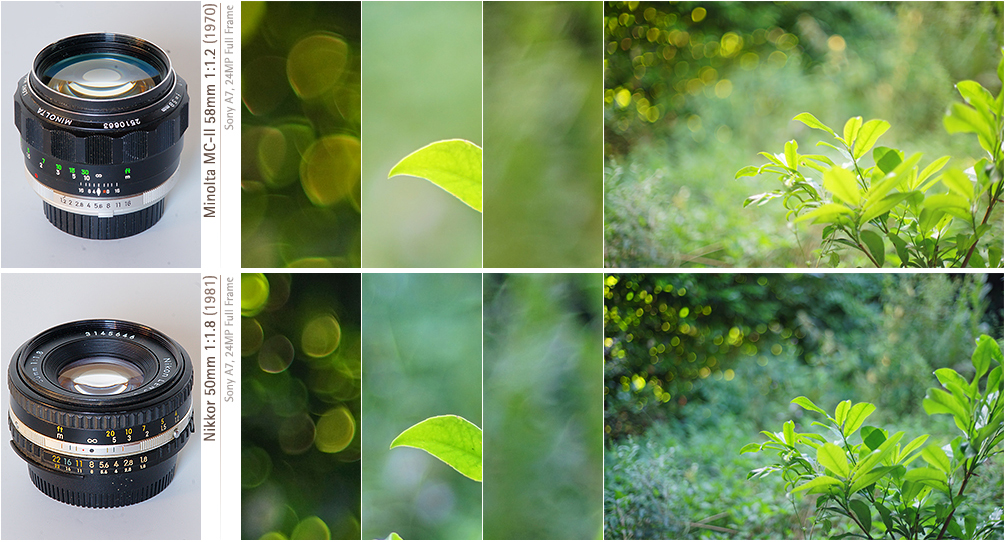
S
_________________
www.artaphot.ch |
|
| Back to top |
|
 |
RokkorDoctor


Joined: 27 Nov 2021
Posts: 1438
Location: Kent, UK
Expire: 2025-05-01
|
 Posted: Thu Mar 31, 2022 8:40 pm Post subject: Posted: Thu Mar 31, 2022 8:40 pm Post subject: |
 |
|
RokkorDoctor wrote:
| stevemark wrote: |
I pretty much agree with most points you said, and of course I like my fast lenses because look nice.
That said, "one aperture faster" can make quite a difference. Look at the images below.
S |
Absolutely. Stops are logarithmic (1.41-log) as far as aperture diameter / bokeh blur are concerned.
Visually that starts to make quite a big difference for every additional stop once you get to the larger apertures.
_________________
Mark
SONY A7S, A7RII + dust-sealed modded Novoflex/Fotodiox/Rayqual MD-NEX adapters
Minolta SR-1, SRT-101/303, XD7/XD11, XGM, X700
Bronica SQAi
Ricoh GX100
Minolta majority of all Rokkor SR/AR/MC/MD models made
Sigma 14mm/3.5 for SR mount
Tamron SP 60B 300mm/2.8 (Adaptall)
Samyang T-S 24mm/3.5 (Nikon mount, DIY converted to SR mount)
Schneider-Kreuznach PC-Super-Angulon 28mm/2.8 (SR mount)
Bronica PS 35/40/50/65/80/110/135/150/180/200/250mm |
|
| Back to top |
|
 |
|
|
